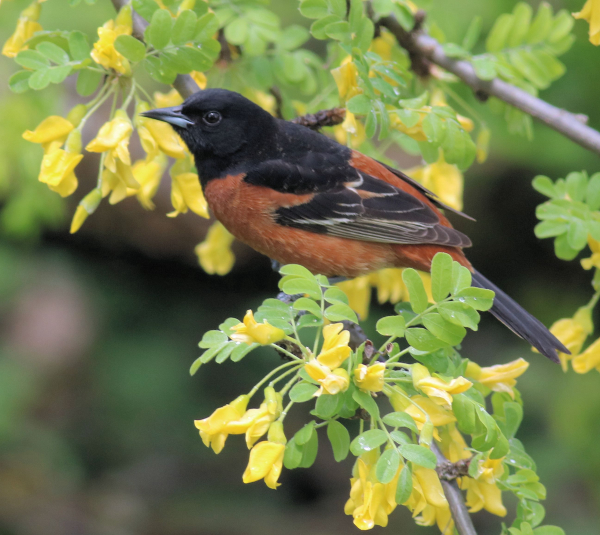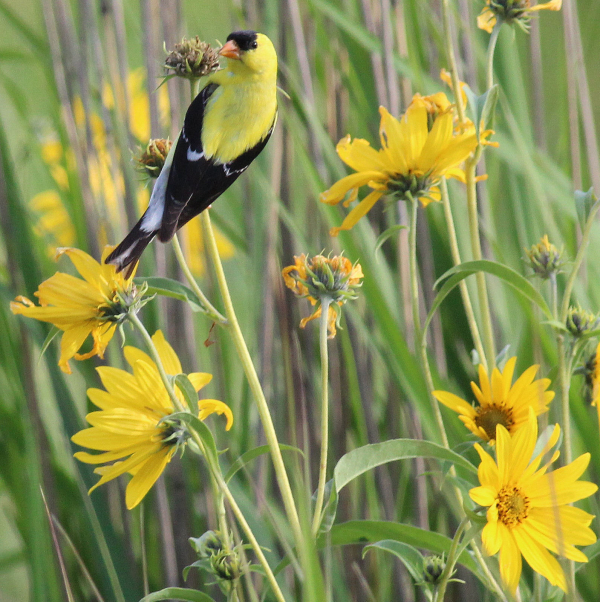 We all have favorite birds that bring color, action, and beautiful songs to our yards, like this male Orchard Oriole, that represents a wealth of species we all appreciate and work to attract and benefit.  A combination of landscaping, foods, and water brings a variety of interesting birds to our yards during May, including American Goldfinches (photos by Paul Konrad). |
How important are our yards, our views of our yard from home, the birds that visit our yard, and the benefits our yards provide for birds? All these factors are priceless, and they can all be appreciated and improved as we enjoy this prosperous season – Spring. This is prime time for your backyard habitat to do its stuff – to attract the greatest number of birds during the peak of May bird activities. NOW is when we “harvest the fruits” of our birding efforts at home! The feeding station, water feature, and landscaping that we provide with hopes of observing and benefitting birds day by day.
Looking for one example of a yard, we asked The Birding Wire’s editor, Paul Konrad, to describe his yard and his viewing options from home and office. While he admits it’s a work in progress, and that it improves each season, that’s part of the enjoyment, and part of the challenges each month.
Birding central in Paul’s yard is outside his old farmhouse’s walk-in bay addition that features four tall clean new windows. That’s where his feeding station is set up and where most of the feathered action happens. His feeders include a hopper feeder filled with shelled mixed seeds and nuts, a hot chili suet feeder, plus the seasonal oriole feeder for orange halves and grape jelly, and a hummingbird nectar feeder. A simple birdbath is filled with fresh water and fitted with a small solar fountain that keep the water circulating to further entice migrating birds. There are also two branches he “planted” as additional perches just above feeder heights, while the adjacent ash tree and a little grove of sumac to the east provide plenty of perches.
Landscaping should include a variety of heights and textures, ranging from flowering and fruiting plants along with escape or protective cover, perches, roosting sites, and nesting habitat. Paul’s yard has a mix of mature and new growth, including seven mature ash trees, a younger maple tree, and a tall aged spruce tree. Ranging from ground level to 10 feet high, a long tall stand of chokecherry bushes provides flowers fruits and cover leads to an equally tall and robust stand of lilac bushes, that yields to a small grove of sumac with tall, medium, and sapling sizes with a walkthrough pathway. There is some dead wood – one smallish dead tree trunk – but he intends to add a bigger snag for woodpeckers and nuthatches soon. There are already two small nest boxes for cavity nesters, along with a big nest box.
There is plenty of ground cover throughout the chokecherries, lilacs, and sumac, and there are mature vines of wild grapes that climb up one mature ash tree and a few chokecherries. Last summer Paul planted two sizes of ferns beneath the spruce tree and in front of the lilacs, providing some thicker ground cover and another splash of green used by thrushes, towhees, and native sparrows. There is also a large mature stand of tall ferns on the northwest side of his house.
Paul allows the grass around all the ash trees to grow long grass around the trunk bases and head out each summer and provides a fine natural edge to the yard. There are a couple areas of sunny open lawn bordered by a couple areas of shaded lawn, both areas with some ovals of tall grass that’s permitted to head out. One grassy oval has a large rock that provides an accent and a perch for kingbirds and robins. He allows the chokecherries and sumac to expand into adjacent lawn areas, which progresses a few feet per year. Most recently, Paul planted some red dogwoods that produce berries in early fall. And no cats are allowed within Paul’s eye-scan, which is a considerable distance.
Paul summed things up with a few thoughts: “When you think about it, we have an opportunity to replace and improve portions of lost habitat via our yards to offset past reductions in native songbird populations. I get great satisfaction from the birds that visit my yard, and I’m happy to say it attracts a variety of birdlife including thrushes, thrashers, towhees, native sparrows, juncos, finches, hummingbirds, orioles, warblers, vireos, grosbeaks, grackles, nuthatches, creepers, woodpeckers, and flycatchers, with new birds arriving every year! I’ve also had crossbills and chickadees here in previous years, and swallows, owls, hawks, falcons, crows, and ducks occasionally perch in my trees. I encourage everyone to enjoy your yard and do all you can to make it more bird-friendly each season.”
Every yard that provides food, water, and cover makes a difference to our native birds, and when we add all bird-friendly yards together, across towns and cities, counties and states, all those properties add up to ever-better replacement habitats in rural, urban, and suburban areas for bird populations across North America – Every Yard Counts!
Share your birding experiences and photos at editorstbw2@gmail.com
